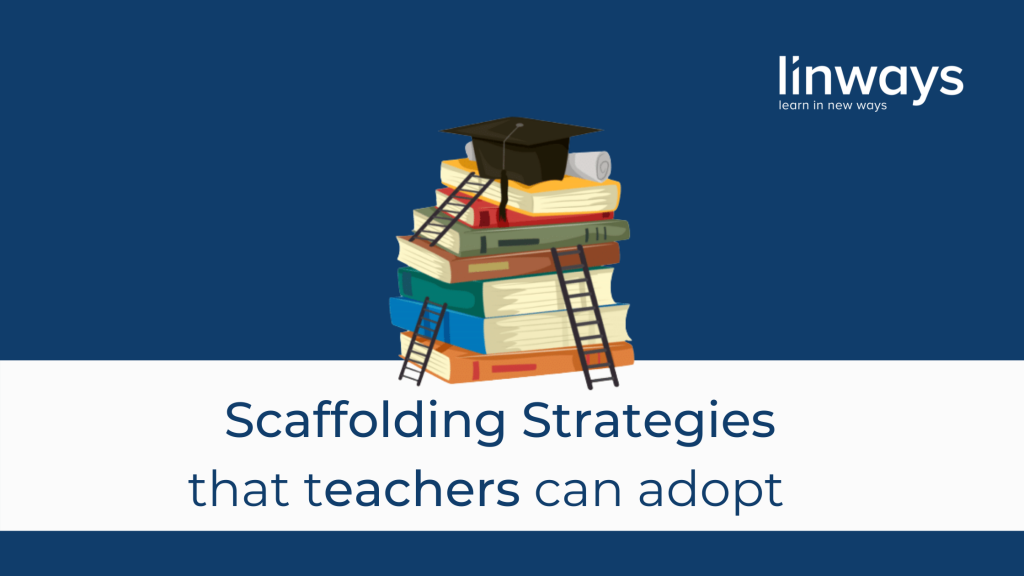
“Scaffolding refers to a method in which the learning contents are broken into small chunks/ modules and providing a tool or structure with which students can learn and develop a new concept or skill”
Scaffolding strategies that teachers adapt can make their student’s learning process easier. Scaffolding directs the students to follow appropriate methodology on how to learn specific topics or solve problems.
The process can be better understood with the process of baking a cake, initially to attain the desired shape the baker pours the batter into a mold. Once it is baked and the desired shape is obtained then the mold is removed. A similar process is applicable in the case of students also, initially support can be given for the students. Once they understand the process and start producing visible results the teachers can gradually remove the scaffolds to enable independent learning.
The types of scaffolding strategies that can be applied in a classroom depends on the factors such as learning outcomes, course and students.
In the learning process scaffolding techniques are generally classified into three types :
- Sensory Scaffolding
Making use of prototypes or visual elements to explain and understand things is known as sensory scaffolding. It helps learners to use their senses to understand and abstract contents easier. - Graphic Scaffolding
Teaching with the aid of charts, tables and infographics are termed as graphic scaffolding. This approach is effective when workflows and conceptual ideas need to be communicated. - Interactive Scaffolding
Interactive scaffolding is a process in which learning is done through socialization and interactive activities. A simple example of interactive scaffolding can be explained as, suppose the objective is to teach the functioning of the vital system of the human body. Dividing a class into different groups and asking them to learn each system and conducting an interactive session to present the things that each group had learnt. It helps in collaborating with different ideas each group learned. Also when students are made to explain in their own words it would be easier for the peers to understand.
Using the techniques mentioned, numerous scaffolding strategies can be implemented in classrooms. Let’s have a look at the top 5 effective strategies:
1. Give Bite-Sized Contents
Teaching new content by breaking it down into bite-sized information makes the learning process easier for the students. It also moves them progressively towards a better understanding.
2. Show / Demonstrate and Explain Contents
We can learn better out of any concepts by seeing or experiencing them rather than listening or reading about it. Always demonstrating content and lessons leads to retention of the concept for the long term in students’ memory.
Example :
Try an activity that explains the properties of magnets and identifies magnetic and non-magnetic materials.
Before the demonstration, explaining the objective of the activity is very essential.
Bringing out the magnet into the classroom and when iron nails are brought near it is attracted by the magnet. This explains the property of a magnet to attract certain objects. Later when paper pieces are brought near it, they won’t be attracted and thus students can differentiate between magnetic and non-magnetic objects.
3. Slow Down and Give Process Time
It is often observed that In a rush to cover portions lessons are taught in a fast-paced manner. But it often inhibits the students from understanding things better. Instead of following that strategy, slowing down the pace of content delivery, pausing at various points, asking questions to check understanding helps the students to learn better and makes them more attentive in class.
4. Deliver Prior Knowledge/ Prerequisites
Before delivering the actual topic, introducing the keywords used in the topic and revising any formulas or concepts that will be applied in the new topic helps the students to grasp the lessons clearly.
5. Enabling Buddy System
In a classroom, we can observe students with numerous skills, each of them tends to be good at one skill or another. Creating buddy pairs in such a way that joining weaker and stronger students helps them to act as a coach for the other. It helps them to communicate with each other in their own words, clarify doubts, use mnemonics and learn things. Training them to coach each other is also essential in this system.
In this blog, we have covered the top 5 and effective scaffolding strategies. Similarly, a lot more strategies are present which can be applied based on the type of course, students, and outcomes. Let us give our students a small scaffold for each step they take and make them self-reliant over time in their learning journey.
Also published on Medium.




